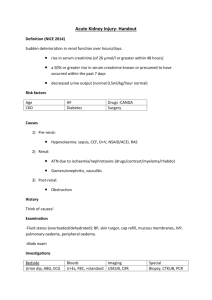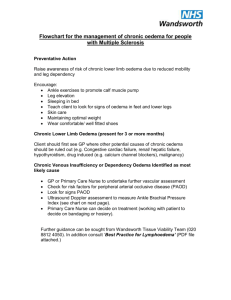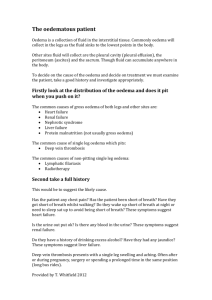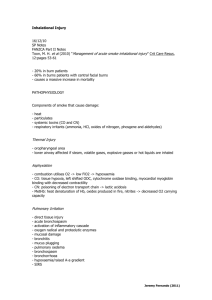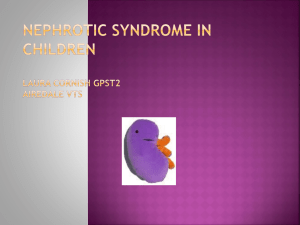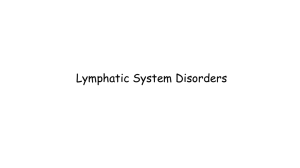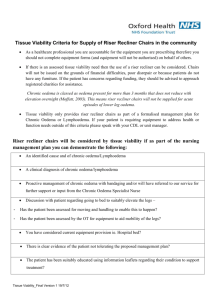Drugs and Lymphoedema: Those Which May Cause Oedema or
advertisement
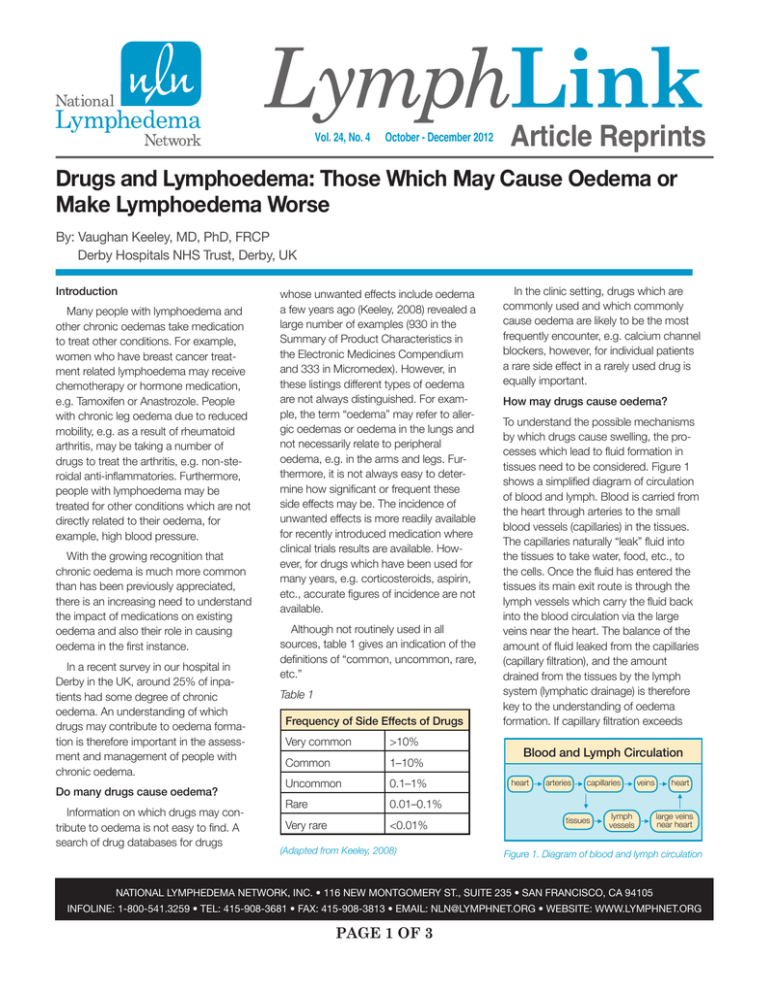
Vol. 24, No. 4 October - December 2012 Article Reprints Drugs and Lymphoedema: Those Which May Cause Oedema or Make Lymphoedema Worse By: Vaughan Keeley, MD, PhD, FRCP Derby Hospitals NHS Trust, Derby, UK Introduction Many people with lymphoedema and other chronic oedemas take medication to treat other conditions. For example, women who have breast cancer treatment related lymphoedema may receive chemotherapy or hormone medication, e.g. Tamoxifen or Anastrozole. People with chronic leg oedema due to reduced mobility, e.g. as a result of rheumatoid arthritis, may be taking a number of drugs to treat the arthritis, e.g. non-steroidal anti-inflammatories. Furthermore, people with lymphoedema may be treated for other conditions which are not directly related to their oedema, for example, high blood pressure. With the growing recognition that chronic oedema is much more common than has been previously appreciated, there is an increasing need to understand the impact of medications on existing oedema and also their role in causing oedema in the first instance. In a recent survey in our hospital in Derby in the UK, around 25% of inpatients had some degree of chronic oedema. An understanding of which drugs may contribute to oedema formation is therefore important in the assessment and management of people with chronic oedema. Do many drugs cause oedema? Information on which drugs may contribute to oedema is not easy to find. A search of drug databases for drugs whose unwanted effects include oedema a few years ago (Keeley, 2008) revealed a large number of examples (930 in the Summary of Product Characteristics in the Electronic Medicines Compendium and 333 in Micromedex). However, in these listings different types of oedema are not always distinguished. For example, the term “oedema” may refer to allergic oedemas or oedema in the lungs and not necessarily relate to peripheral oedema, e.g. in the arms and legs. Furthermore, it is not always easy to determine how significant or frequent these side effects may be. The incidence of unwanted effects is more readily available for recently introduced medication where clinical trials results are available. However, for drugs which have been used for many years, e.g. corticosteroids, aspirin, etc., accurate figures of incidence are not available. Although not routinely used in all sources, table 1 gives an indication of the definitions of “common, uncommon, rare, etc.” Table 1 Frequency of Side Effects of Drugs Very common >10% Common 1–10% Uncommon 0.1–1% Rare 0.01–0.1% Very rare <0.01% (Adapted from Keeley, 2008) In the clinic setting, drugs which are commonly used and which commonly cause oedema are likely to be the most frequently encounter, e.g. calcium channel blockers, however, for individual patients a rare side effect in a rarely used drug is equally important. How may drugs cause oedema? To understand the possible mechanisms by which drugs cause swelling, the processes which lead to fluid formation in tissues need to be considered. Figure 1 shows a simplified diagram of circulation of blood and lymph. Blood is carried from the heart through arteries to the small blood vessels (capillaries) in the tissues. The capillaries naturally “leak” fluid into the tissues to take water, food, etc., to the cells. Once the fluid has entered the tissues its main exit route is through the lymph vessels which carry the fluid back into the blood circulation via the large veins near the heart. The balance of the amount of fluid leaked from the capillaries (capillary filtration), and the amount drained from the tissues by the lymph system (lymphatic drainage) is therefore key to the understanding of oedema formation. If capillary filtration exceeds Blood and Lymph Circulation heart arteries capillaries tissues veins lymph vessels heart large veins near heart Figure 1. Diagram of blood and lymph circulation NATIONAL LYMPHEDEMA NETWORK, INC. • 116 NEW MONTGOMERY ST., SUITE 235 • SAN FRANCISCO, CA 94105 INFOLINE: 1-800-541.3259 • TEL: 415-908-3681 • FAX: 415-908-3813 • EMAIL: NLN@LYMPHNET.ORG • WEBSITE: WWW.LYMPHNET.ORG PAGE 1 OF 3 lymphatic drainage, fluid will accumulate in the tissues and oedema forms. Drugs may have an impact on either or both of these processes but perhaps most commonly cause an increase in capillary filtration. For example, drugs which make the body retain fluid cause an increase in blood volume which leads to an increase in pressure of the capillaries and an increase in capillary filtration. This will cause swelling if the lymph system cannot keep up with the extra fluid. Drugs which may do this include corticosteroids, non-steroidal anti-inflammatory drugs, e.g. ibuprofen, and hormones, e.g. oestrogens. Other drugs may cause increased capillary filtration by increasing the amount of blood which flows into the capillaries as a result of dilation of the small arteries which carry blood to the capillaries, e.g. calcium channel blockers such as amlodipine. Calcium channel blockers such as amlodipine also reduce lymph drainage by reducing the regular spontaneous contractions of muscle in the lymph vessels which propel lymph back towards the heart. (Toland et al, 2000). For a number of drugs however, it is not clear how the oedema is caused. The introduction of new treatments can also alter the clinical picture seen in lymphoedema clinics. For example, the chemotherapy agent Docetaxel is now frequently incorporated into the routine chemotherapy regimen for the adjuvant treatment of breast cancer. Docetaxel may cause severe fluid retention with oedema of the legs or more generalised swelling (including abdominal swelling). This usually occurs after 4-5 courses of Docetaxel and may take on average 29 weeks to resolve following discontinuation. The use of corticosteroids with the Docetaxel may reduce the problem. It can also be treated with diuretics. In addition a recent meta-analysis has shown that women who have Docetaxel as part of their treatment for breast cancer may be 6 times more likely to develop arm lymphoedema than those who do not (Qin et al, 2011). The drug Everolimus has recently been employed as part of a number of cancer treatments, and we are seeing patients in clinic with oedema seemingly related to this. It is likely that this drug, like the related drug, Sirolimus, causes oedema by affecting the way that lymph vessels repair themselves. It is therefore, recommended that clinicians take note of new medications which patients are taking as part of their full assessment. Interpretation of data on the frequency of side effects Much modern data on (the frequency of) side effects are derived from placebo controlled clinical trials (in which a new drug is compared with an inactive one) or trials of one drug compared with another. The interpretation of the results of the former may be complicated by the fact that the illness for which the drug is used may cause oedema (seen in the placebo group). In the latter, both drugs may cause oedema as an unwanted effect. The effects of the drug in question on oedema is therefore not always immediately clear. For example, in a study of Raloxifene in older post-menopausal women compared with placebo, the frequency of peripheral oedema in the patients taking Raloxifene was 14.4% and in patients taking placebo was 12.1% (Barrett-Connor et al, 2006). As this is a placebo study, it is implied that this group of patients had a natural frequency of peripheral oedema of around 12% which was increased to 14% with Raloxifene. To further complicate interpretation, it is clear that the combination of drugs may affect the incidence of oedema. The drug Rosiglitazone caused oedema in 4.8% of people in whom it was used alone to treat diabetes, but in combination with Insulin the frequency increased to 14.7% (Micromedex, 2007). Specific drugs 1.Calcium channel blockers. These are probably the most frequently seen cause of oedema or worsening of oedema in our clinical practice. They are frequently used in the treatment of hypertension and angina. They cause oedema in a dose dependent fashion. (see table 2) In our clinical experience, we occasionally see patients whose leg oedema is solely caused by calcium antagonists. Withdrawal and discontinuation of the medication may lead to complete resolution of the oedema in these cases. PAGE 2 OF 3 Drug Dose (per day) Frequency (%) Amlodipine 2.5 mg 5 mg 10 mg 1.8 3.0 10.8 Felodipine 2.5 mg 5 mg 10 mg 2 8.8 17.4 Nifedipine up to 180 mg 7-50 Table 2. Frequency of oedema compared with dose of calcium channel blocker (adapted from Keeley, 2008) Sometimes there is a clear relationship between the introduction of one of these drugs and the exacerbation of chronic leg swelling. If this is the case, then dose reduction and/or withdrawal of the drug should be considered. In some instances it is not always clear whether the calcium channel blocker is contributing to the oedema or not. In these circumstances continuation of the drug, particularly if it is an effective agent for managing another condition, e.g. high blood pressure, is recommended. 2. Corticosteroids Corticosteroids e.g. Prednisolone and Dexamethasone are well recognised causes of peripheral oedema. They cause sodium and water retention. The effect is dependent upon the duration of treatment and the dose. People receiving short courses of corticosteroid steroids over 1-2 weeks for asthma do not tend to develop much oedema, whereas those on long-term corticosteroids can experience significant swelling. Figure 2 shows the legs of a man who has been taking Prednisolone for a rheumatological condition for one year. Prior to starting this, he had no leg swelling. Clinically the Prednisolone seems to be the cause. The clinical features of the swelling may not be specific to Prednisolone but people on long-term corticosteroids may exhibit other side effects, e.g. “moon-face”, thinning of the skin and bruising. Withdrawal Fig 2. Leg oedema due to Prednisolone of the steroids, if possible clinically, leads to improvement in the swelling but there may be a significant delay between the cessation of corticosteroids and this improvement. In some instances where the corticosteroids are essential, the use of diuretics to counteract the fluid retaining effect may be beneficial. 3. Sex, hormones and related compounds. These also seem to cause oedema by inducing fluid retention. The frequency for different hormones is given in Table 3. Oestrogens (HRT) >1% Anastrozole 7-10% Tamoxifen 8-9% Megestrol 14% Table 3. Frequency of oedema caused by hormones (adapted from Keeley, 2008) As can be seen from this table, some of these drugs are essential in the management of breast cancer and depending upon the benefit of the drugs, a clinical decision about whether to continue with them or change to an alternative may need to be considered. 4.Other drugs. Table 4 gives examples of other drugs where oedema can be quite a common side effect. Clinical assessment of the importance of drugs in individual patients In assessing the importance of drugs, which may be playing a part in the clinical picture of oedema the following should be considered: 1.Is there a clear time relationship between the use of the drug and the effect on the oedema? It should be noted that the oedema does not always appear immediately and may take a few weeks, e.g. in the case of corticosteroids, to become evident. 2.Is oedema a well recognised side effect of the drug concerned? It is suggested that databases of unwanted drug effects are consulted but it should be borne in mind that for an individual patient a rare effect is just as important as a common effect. Other Drugs Anticonvulsants (for epilepsy) e.g. Pregabalin 5-12% Antidepressants e.g. Trazodone 10% Antidiabetics e.g. Rosiglitazone 5% Antipsychotics e.g. Risperidone 16% Bisphosphonates (e.g. breast cancer treatment) e.g. Zoledronic Acid 21% Cytotoxic chemotherapy e.g. Docetaxel 47-64% Others e.g. Baclofen (for muscle spasms) 1-10% Sirolimus (in transplants) >10% Table 4. The frequency of oedema caused by other drugs. (Adapted from Keeley, 2008) 3.Are there signs of more widespread oedema? For example, if somebody is being treated for arm lymphoedema, have the legs become swollen? If somebody is being treated for unilateral leg lymphoedema, has the other leg become swollen? Evidence of more widespread oedema may help in determining whether a drug effect is important. If a drug effect is suspected how should this be managed? In some situations e.g. new onset oedema caused by a drug such as a calcium channel blocker, withdrawal or discontinuation of the drug is the best way forward. For many people with hypertension alternative drugs are available which do not have the same side effect. In some cases where conditions such as hypertension have been difficult to manage, a dose reduction in the drug may bring about an improvement in oedema without compromising the control of high blood pressure. On occasion, if the oedema is not too severe, it may be possible to manage it by other means e.g. compression garments, PAGE 3 OF 3 when the drug concerned is considered to be an important part of managing the persons other illnesses. In some circumstances, e.g. as described above with corticosteroids, diuretics may play a part in managing the side effects. If diuretics are used long term, it should be remembered that sudden withdrawal of these drugs can make oedema worse and therefore gradual reduction and withdrawal over a period of weeks is recommended. Conclusions The cause of chronic oedema in many patients is often multi-factorial. Drugs can play a significant part in the aetiology and therefore it is recommended that they are considered in the initial assessment of patients presenting with chronic oedema, but also when existing oedema worsens. In some situations, withdrawal of the drugs is appropriate, whereas in others it may not be possible. Any proposed changes to medications should always be discussed with the prescribing physician and patients should be cautioned not to discontinue medication on their own. References Keeley V. Drugs that may exacerbate and those used to treat lymphoedema. Journal of Lymphoedema (2008) Vol 3, No 1: 57-65 Toland HM, McCloskey K.D, Thornbury K.D, et al Calcium activated chloride current in sheep lymphatic smooth muscle. American Journal Physiology Cell Physiology (2000) 279:C1327-1335 Qin Y. Y, Guo X.J, Ye X.F et al. Adjuvant Chemotherapy with or without Taxanes, in Early or Operable Breast Cancer : A Meta-Analysis of 19 Randomized Trials with 30698 patients. PLoS ONE (2011) 11,e26946 Barrett-Connor E, Mosca L, Collins P, et al Effects of Raloxifene on Cardiovascular Events and Breast Cancer in Postmenopausal Women. The New England Journal of Medincine (2006) 355(2): 125–37 Micromedex R Healthcare Series (2007) Available online at: www.micromedex.com
